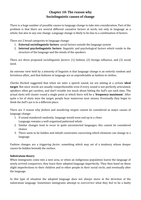Samenvatting
Aitchison, J. (2013). Language Change: Progress or Decay? 4th ed. - Summary Chapter 10
- Instelling
- Universiteit Van Amsterdam (UvA)
- Boek
- Language Change
Dit zijn samenvattingen voor het vak Linguistics: Language variation and change. Deze samenvattingen zijn zowel op het boek van Aitchinson gebaseerd, als op de belangrijkste informatie uit de lessen.
[Meer zien]





